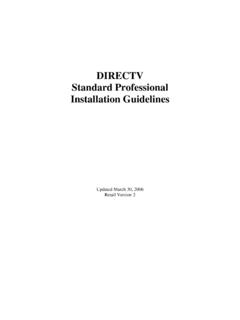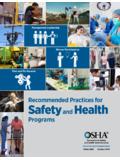Transcription of INDG423 - Managing work-related violence in licensed and ...
1 Health and Safety Executive Managing work -related violence in licensed and retail premises Health and Safety Executive Introduction Managing work -related violence in licensed and retail premises Are you doing enough to prevent and manage violence or anti-social behaviour in your workplace? This leaflet contains information and practical advice on how to assess and tackle the risk of violence to your staff. The advice is based on what people who work in pubs, clubs and shops have told us about their experience of tackling violence where they work , including measures that have helped combat the problem.
2 More detailed information can be found in a toolkit on the HSE website at: This is a web-friendly Why should you be concerned? version of leaflet INDG423 . Impact on your staff Physical injury work -related stress which can have long-term effects on health Fear and anxiety Job dissatisfaction and poor performance Impact on your business Lost staff time from injuries and stress Higher staff turnover, leading to increased recruitment and training costs Damage to the reputation of your business Potential compensation claims by staff What should you be doing? You have a legal duty to protect the health, safety and welfare of your employees, under the Health and Safety at work Act 1974.
3 This duty includes all forms of work -related violence , which HSE defines as: Any incident in which a person is abused, threatened or assaulted in circumstances relating to their work '. This means: physical violence including kicking, spitting, hitting or pushing, as well as more extreme violence with weapons;. verbal abuse including shouting, swearing or insults, racial or sexual abuse;. threats and intimidation. Tackling the risk of violence is the same as dealing with any other possible cause of harm in the workplace, such as slips and trips and lifting heavy loads. 1 of 14 pages Health and Safety Executive You are required by law to carry out a risk assessment.
4 The following pages have advice on how to do this and there is more information at: The risk assessment will help you find out whether violence is a problem for your staff and your business, and how you can improve the situation. It will help you devise a policy and procedures for dealing with violence , as part of a wider health and safety policy for your business. Assessing the risks of work -related violence Step 1: Identify the hazards A hazard is something that can cause harm in this case violence and aggression. There are a number of ways you can gather this information. Ask your staff and safety representatives about their experiences and concerns.
5 Look back at your accident and ill-health records. Read the information on HSE's website, including the toolkit ( ) and related case studies. licensed premises The main causes of violence in pubs/clubs include: disagreements between customers;. customers being drunk;. customers who have used illegal drugs. retail premises The main causes of violence in shops include: the unpredictable behaviour of shoplifters and drug users;. verbal abuse (this is more common than physical violence ). Step 2: Who might be harmed and how? work out whether and how violence , or the fear of violence , could affect workers or other people in your workplace.
6 Think about whether there are any special groups of workers who have different or additional risks, for example lone workers or trainees. licensed premises In pubs/clubs, entrances can be hot spots' for violence . Clubs are sometimes more at risk because customers have been drinking for longer by the time they get there. People working in pubs and clubs experience: frequent verbal abuse;. physical assaults, including the use of weapons;. racial discrimination. Managing work -related violence in licensed and retail premises 2 of 14 pages Health and Safety Executive retail premises People working in retail premises are more at risk at opening and closing times, or when dealing with complaints or returned items.
7 The types of violence they experience include: frequent verbal abuse (some staff still see this as part of the job');. physical assaults, including use of weapons. Who is at risk? You need to identify which groups of people in your business could be harmed by physical assaults, threats, intimidation or verbal abuse. Think about all the individuals you have in your workplace at any time. This may include people who do not have regular shifts or work patterns, for example maintenance staff, security staff and other contractors. You should also consider customers, guests and members of the public.
8 Talk to people about situations where they feel threatened, as well as situations that might be risky, even if they do not cause concern at the moment. Some groups of staff may be more at risk of experiencing work -related violence . These include young workers, trainees, temporary workers, night/shift workers and lone workers. You may need to consider extra control measures for them. Young workers and trainees may be more at risk because they have had less training on how to deal with angry customers, robbery and sexual harassment. They may also have more difficulty recognising dangerous situations through lack of experience.
9 Temporary workers may be more at risk because they may have received less training or information on work -related violence than permanent staff. Night/shift workers, including late evening workers, can be at greater risk as more violent incidents occur at night time. Also, certain days of the week or certain times are more hazardous, for example opening and closing times or during delivery of goods. Key holders can feel particularly vulnerable. Lone workers can be at greater risk as they do not have the support of colleagues who could deter potential attackers, or provide immediate help and support if there is a problem.
10 Further information on lone working can be found on the HSE website at: Step 3: Evaluate the risks and decide on precautions work out what you are already doing, whether your control measures are working properly and if there is anything else you need to do. This will help you decide whether you are doing enough. It is also good practice to ask your staff for their ideas and feedback. What are the risks? The way that many licensed and retail businesses operate can increase the chances of violence occurring. For example: handling large amounts of cash;. staff having face-to-face contact with customers.













